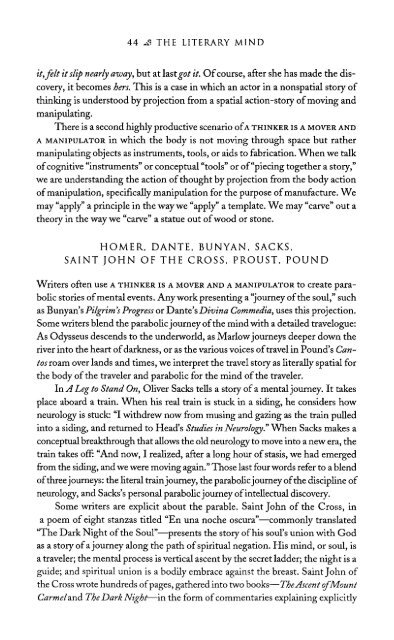The Literary Mind.pdf
The Literary Mind.pdf
The Literary Mind.pdf
Create successful ePaper yourself
Turn your PDF publications into a flip-book with our unique Google optimized e-Paper software.
44 THE LITERARY MIND<br />
it, felt it slip nearly away, but at last got it. Of course, after she has made the discovery,<br />
it becomes hers. This is a case in which an actor in a nonspatial story of<br />
thinking is understood by projection from a spatial action-story of moving and<br />
manipulating.<br />
<strong>The</strong>re is a second highly productive scenario of A THINKER is A MOVER AND<br />
A MANIPULATOR in which the body is not moving through space but rather<br />
manipulating objects as instruments, tools, or aids to fabrication. When we talk<br />
of cognitive "instruments" or conceptual "tools" or of "piecing together a story,"<br />
we are understanding the action of thought by projection from the body action<br />
of manipulation, specifically manipulation for the purpose of manufacture. We<br />
may "apply" a principle in the way we "apply" a template. We may "carve" out a<br />
theory in the way we "carve" a statue out of wood or stone.<br />
HOMER, DANTE, BUNYAN, SACKS,<br />
SAINT JOHN OF THE CROSS, PROUST, POUND<br />
Writers often use A THINKER is A MOVER AND A MANIPULATOR to create parabolic<br />
stories of mental events. Any work presenting a "journey of the soul," such<br />
as Bunyan's Pilgrim's Progress or Dante's Divina Commedia, uses this projection.<br />
Some writers blend the parabolic journey of the mind with a detailed travelogue:<br />
As Odysseus descends to the underworld, as Marlow journeys deeper down the<br />
river into the heart of darkness, or as the various voices of travel in Pound's Cantos<br />
roam over lands and times, we interpret the travel story as literally spatial for<br />
the body of the traveler and parabolic for the mind of the traveler.<br />
In A Leg to Stand On, Oliver Sacks tells a story of a mental journey. It takes<br />
place aboard a train. When his real train is stuck in a siding, he considers how<br />
neurology is stuck: "I withdrew now from musing and gazing as the train pulled<br />
into a siding, and returned to Head's Studies in 'Neurology:" When Sacks makes a<br />
conceptual breakthrough that allows the old neurology to move into a new era, the<br />
train takes off: "And now, I realized, after a long hour of stasis, we had emerged<br />
from the siding, and we were moving again." Those last four words refer to a blend<br />
of three journeys: the literal train journey, the parabolic journey of the discipline of<br />
neurology, and Sacks's personal parabolic journey of intellectual discovery.<br />
Some writers are explicit about the parable. Saint John of the Cross, in<br />
a poem of eight stanzas titled "En una noche oscura"—commonly translated<br />
"<strong>The</strong> Dark Night of the Soul"—presents the story of his soul's union with God<br />
as a story of a journey along the path of spiritual negation. His mind, or soul, is<br />
a traveler; the mental process is vertical ascent by the secret ladder; the night is a<br />
guide; and spiritual union is a bodily embrace against the breast. Saint John of<br />
the Cross wrote hundreds of pages, gathered into two books—<strong>The</strong> Ascent of Mount<br />
Carmel and <strong>The</strong> Dark Night—in the form of commentaries explaining explicitly















